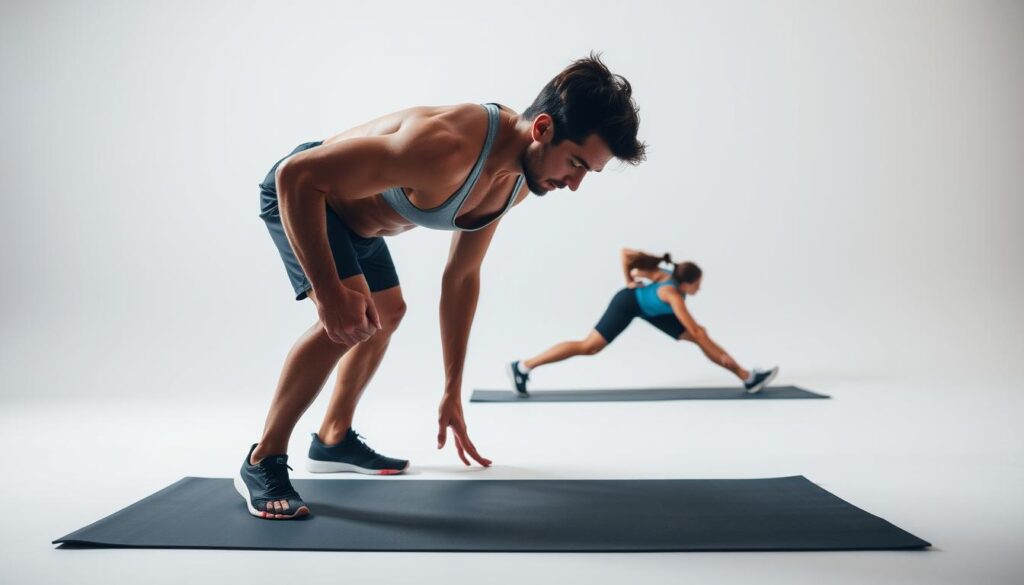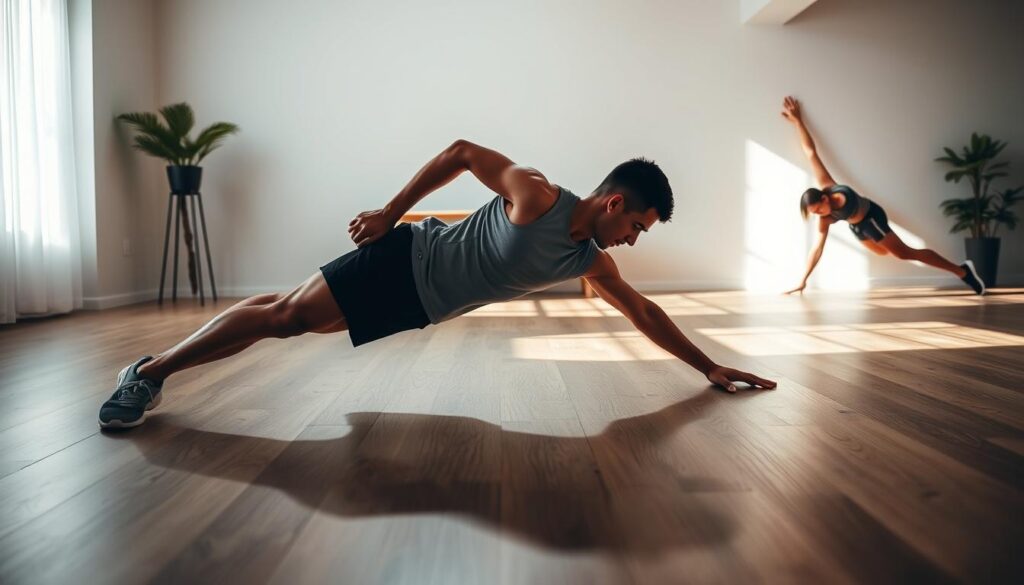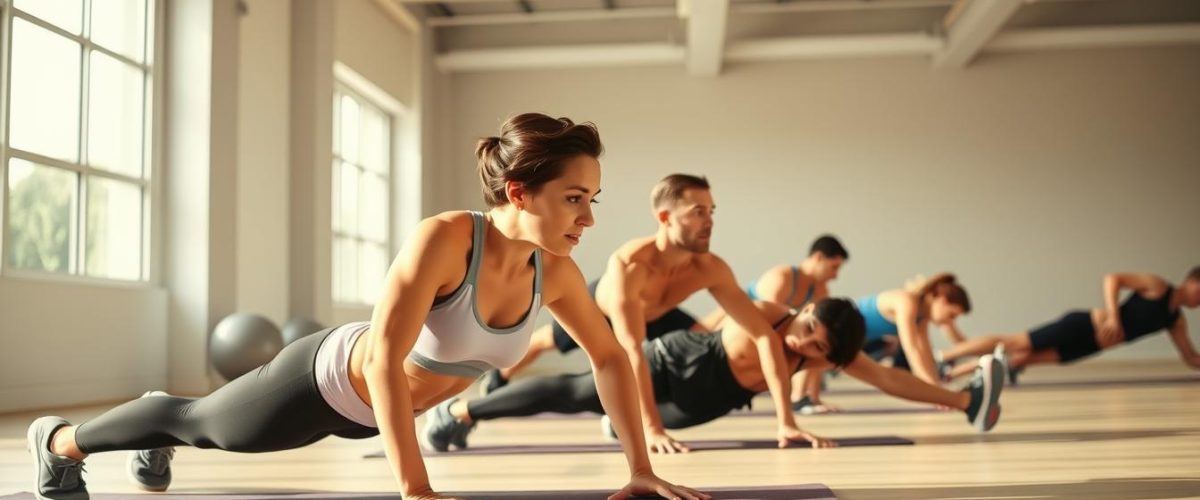As a runner, you know how crucial a strong base is. A robust core is the backbone of your running performance. It helps you keep good posture, generate power, and run long distances.
But, running injuries are common. Nearly 30% of runners get injured each year. Yet, adding effective core strengthening routines to your training can lower injury risk and boost your running efficiency with running core workouts.
By doing key core stability exercises, you can better your running and stay injury-free.
What is Core Stability and Why It Matters for Runners?
(running core workouts Exercises)
Core stability is key for runners. It helps your spine and keeps your posture right while running. A strong core makes you run better, saves energy, and boosts your performance.
Understanding Core Stability
Core stability is more than strong abs. It’s about all your muscles working together for stability. It includes your abs, obliques, lower back, and hip flexors to keep you stable. This is important for moving energy well from your upper to lower body.
Benefits of a Strong Core for Runners
A strong core helps runners a lot. It makes running better, lowers injury risk, and boosts performance. Key benefits include:
- Improved running posture
- Increased running efficiency
- Reduced energy waste
- Enhanced overall performance
To see core stability benefits, compare runners with and without strong cores:
| Characteristics | Runners with Strong Core Stability | Runners without Strong Core Stability |
|---|---|---|
| Running Posture | Upright and stable | Slouched or uneven |
| Running Efficiency | High efficiency | Low efficiency |
| Injury Risk | Lower risk | Higher risk |
The table shows a strong core’s impact on running. Adding core exercises to your routine can bring these benefits to life.
Key Muscles Involved in Core Stability
(running core workouts Exercises)
Knowing the muscles that help with core stability is key for runners. It’s not just about strong abs. It’s about the strength and teamwork of many muscles.
Abdominals
The abdominal muscles, like the rectus abdominis and transverse abdominis, are very important. The rectus abdominis helps bend the spine. The transverse abdominis tightens around the belly, keeping the spine stable. Doing planks and crunches can make these muscles stronger.
Obliques
The obliques, which are the internal and external obliques, are key for twisting and bending to the sides. They help keep the body straight and move forces from top to bottom. Side planks and Russian twists are great for working the obliques.
Lower Back Muscles
The lower back muscles, like the erector spinae, help extend and stabilize the spine. They are essential for keeping the back straight while running and avoiding back injuries. Doing superman and bird-dog can help strengthen these muscles.
Hip Flexors
The hip flexors, including the iliopsoas, are important for lifting the knees when running. Strengthening them can make running more efficient and lower injury risks. Lunges and leg raises are good for the hip flexors.
As a runner, adding exercises for these muscles to your routine can boost your core stability. A good core workout might include:
| Muscle Group | Exercises |
|---|---|
| Abdominals | Planks, Crunches |
| Obliques | Side Planks, Russian Twists |
| Lower Back Muscles | Superman, Bird-Dog |
| Hip Flexors | Lunges, Leg Raises |
“A strong core is the foundation of a efficient running style. By targeting the key muscles involved in core stability, runners can improve their performance and reduce their risk of injury.”
Essential Core Stability Exercises for Runners
(running core workouts Exercises)
Core stability exercises are key for runners wanting to improve their technique and avoid injuries. A strong core helps you run more efficiently by giving you a stable base. Let’s look at some top core exercises for runners.
Planks
Planks are a basic exercise for building core strength. Start in a push-up position with your hands shoulder-width apart. Hold this position with your body straight from head to heels. Engage your core by pulling your belly button towards your spine.
Hold the plank for 30-60 seconds, rest for 30 seconds, and do 3-5 sets. Proper form is crucial. Don’t let your hips sag or your back arch.
Side Planks
Side planks target the obliques, important for rotational strength and stability. Lie on your side with your feet stacked and hands under your shoulders. Lift your hips off the ground, keeping your body straight. Keep your core engaged for stability.
Hold for 30-60 seconds on each side, rest for 30 seconds, and repeat for 3-5 sets. Side planks are challenging, so start with a modified version if needed, by bending your knees.
Bird-Dog
The bird-dog exercise boosts core stability and balance by working multiple muscles at once. Start on your hands and knees. Lift your right arm and left leg straight up, holding for a few seconds. Maintain a stable core throughout.
Return to the start and repeat with the opposite arm and leg. Do 3 sets of 10-15 reps on each side. Focus on slow, controlled movements for better results.
Adding these core exercises to your routine can improve your running and lower injury risk. Consistency is important, so practice these exercises often.
Dynamic Core Stability Movements
(running core workouts Exercises)
Advanced core workouts, like dynamic stability movements, boost a runner’s performance and lower injury risk. These exercises challenge your core muscles in a more functional way than static ones.
Runners find these movements great for building core strength and improving neuromuscular coordination. They also enhance athletic performance. Adding dynamic core exercises to your routine can improve your running efficiency, endurance, and stability.
Medicine Ball Throws
Medicine ball throws are a strong exercise for dynamic core strength. They involve explosive movements that work your core, including abs and obliques. To do a medicine ball throw, stand with your feet apart, hold a medicine ball, and twist to throw it against a wall or to a partner.
Benefits of Medicine Ball Throws: They boost rotational strength, core power, and neuromuscular coordination. For best results, use quick, powerful movements and keep your core engaged.
Resistance Band Exercises
Resistance band exercises are also great for a dynamic core workout. They use bands to create tension that your core must fight against. Examples include banded rotations, planks, and leg raises. These exercises are flexible, easy to take anywhere, and can be adjusted for any fitness level.
Tips for Using Resistance Bands: Make sure the band is securely tied, keep good posture, and move slowly and controlled. Adding resistance band exercises to your routine can improve core stability, running posture, and lower injury risk.
Strengthening Your Core at Home
(running core workouts Exercises)
Strengthening your core at home is easy and effective. You don’t need a gym to see big improvements. This guide will show you simple exercises to do at home.
Bodyweight Exercises
Bodyweight exercises are perfect for starting at home. They need no equipment and can be adjusted for any fitness level. Here are some top exercises for a strong core:
- Planks: Hold a position that engages your entire core.
- Bicycle crunches: Targets the obliques.
- Leg raises: Strengthens the lower abs.
Tips for Effective Bodyweight Exercises: Make sure to use the right form to avoid injury. Start with fewer reps and add more as you get stronger.
Using Household Items for Resistance
You can also use common items to make your exercises harder. For example:
- Water bottles or cans can be used as dumbbells.
- A chair or a stability ball can be used for support or to add instability.
- Resistance bands, if you have them, can provide a versatile form of resistance.
| Exercise | Repetitions | Sets |
|---|---|---|
| Plank | Hold for 30 seconds | 3 |
| Bicycle Crunches | 15 per side | 3 |
| Leg Raises | 10 | 3 |
By adding these exercises to your daily routine, you can boost your core stability. This will also improve your running.
How to Incorporate Core Exercises into Your Running Routine
(running core workouts Exercises)
To boost your runs, add core stability workouts to your plan. A good core routine improves your running, posture, and injury risk. It builds the strength and stability for tough runs.

(running core workouts Exercises)
Frequency and Duration
Runners should do core exercises 2-3 times a week. This keeps the core muscles strong without overtraining. Each session should last 15-20 minutes, focusing on the whole core.
“Consistency is key when it comes to core training. By committing to regular core workouts, runners can experience significant improvements in their overall performance and endurance.”
Linking Core Work with Running Sessions
Connecting core work with running is great. You can do core exercises on the same day as a hard run or on a recovery day. Some prefer to do them after their runs, while others like separate days. Find what works for you.
- Do core exercises on recovery days to enhance flexibility and strength.
- Incorporate dynamic core movements after your runs to improve flexibility.
- Use core workouts as a cool-down routine after long or intense runs.
By adding core exercises to your routine, you’ll run stronger and more efficiently. You’ll reach your running goals faster.
Core Stability Workouts for Beginners
(running core workouts Exercises)
For runners starting out, adding core stability exercises to your routine can boost your running. A strong core keeps your form right, lowers injury risk, and boosts performance.
Simple Routines to Start With
Beginners should start with easy core strengthening routines. These should be simple to follow and help build your core strength. Here are some exercises to begin with:
- Plank: Hold a plank for 20-30 seconds, rest for 30 seconds, and repeat for 3-5 sets.
- Bridging: Lie on your back with knees bent and feet flat, lift your hips up, and hold for a few seconds before lowering.
- Leg Raises: Lie on your back, lift one leg up, and then lower it back down without touching the floor. Do the same with the other leg.
Gradual Progressions
Once you’re comfortable with these exercises, it’s time to try harder ones. Increasing the challenge of your core stability workouts will keep pushing your muscles and help you get stronger.
- Make your planks longer or do more reps for other exercises.
- Add dynamic moves like medicine ball throws or Russian twists to work your core harder.
- Try best core exercises for runners like side planks or bird-dog exercises to work different muscles.
Consistency is crucial. Keep practicing these exercises and make them harder over time. This will strengthen your core, improve your running, and lower injury risk.
Tips for Perfecting Core Stability Form
To get the most out of core stability exercises, proper form is key for runners. It helps prevent injuries and boosts running performance.
Common Mistakes to Avoid
Runners should watch out for several common mistakes in core stability exercises. These include:
- Letting the hips sag or lift too high during planks
- Not engaging the core muscles properly
- Using momentum instead of controlled movements
- Not maintaining a straight line from head to heels
Avoiding these mistakes can greatly improve the effectiveness of core activation drills for runners.
Ensuring Proper Alignment
Proper alignment is vital for the best results from running core workouts. Here are some tips to ensure proper alignment:
- Engage your core by drawing your belly button towards your spine
- Maintain a straight line from head to heels during exercises like planks
- Use a mirror or workout buddy to check your form
- Focus on slow, controlled movements
By following these tips, runners can boost their core stability benefits for running. This leads to better overall performance.

(running core workouts Exercises)
Incorporating these tips into your core stability routine can greatly improve your running efficiency and strength. Remember, the key is to maintain proper form and stay consistent with your workouts.
Signs You Need to Focus on Core Stability
(running core workouts Exercises)
If you’re a runner, keeping your core stable is key. But how do you know if you’re not doing well? Your body will show signs that you need to work on core stability exercises for runners.
Warning Signs While Running
Your core muscles are crucial when you’re running. They help keep your posture and stability. If you notice any of these issues, it might mean your core needs more work:
- Lower back pain or discomfort
- Poor running posture
- Increased fatigue during runs
- Feeling unstable or wobbly
These problems often come from weak core muscles. They’re key for good runner’s core stability training. Strengthening your core can help fix these issues and boost your running.
Recognizing Weaknesses in Your Form
Weak spots in your running form can also hint at a need for core strengthening routines. Common issues include:
- Overstriding
- Inadequate hip rotation
- Poor foot strike
Spotting and fixing these weaknesses with core exercises can enhance your running. It can also lower injury risks. Adding core stability exercises for runners to your routine can greatly improve your performance.
Conclusion: Building a Stronger, More Efficient Running Style
(running core workouts Exercises)
Adding core stability exercises to your running routine can greatly improve your performance. You’ll notice better posture, more endurance, and a lower risk of injury. A strong core is essential for efficient running.
Prioritizing Core Work for Enhanced Performance
To boost your running, include advanced core workouts in your training. These exercises enhance your performance and prepare you for tough runs.
Activating Your Core for Optimal Running
Core activation drills are key for runners. They build the strength and stability needed for good running form. Engaging your core helps keep you aligned and boosts power with each step.
Focus on core work to better your running style, lower injury risk, and reach your goals. Make core stability a core part of your training to see the benefits.



One Response